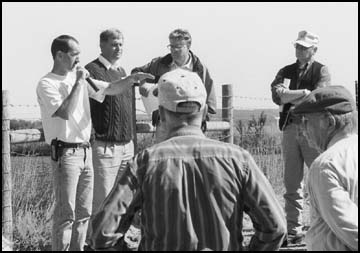 In conjunction with one of its monthly meetings, the Minnesota Board of Water and Soil Resources (BWSR) toured several feedlots in Stearns County last Wednesday.
In conjunction with one of its monthly meetings, the Minnesota Board of Water and Soil Resources (BWSR) toured several feedlots in Stearns County last Wednesday. The board--which is comprised of three county commissioners, three Soil and Water Conservation District Supervisors, three watershed representatives, three citizens, and five representatives from state agencies--acts as a conduit between the state and the local bodies of government that actually initiate most conservation projects.
"We try to get out of St. Paul and look at different areas of the state at least a few times a year," said Ron Harnack, BWSR executive director. "This is the best way for us to keep in touch with what soil and water conservation districts and counties are doing to manage resources locally."
Keith Schaefer explains some features of his family's dairy farm to tour group that included the Minnesota Board of Water and Soil Resources.
On Wednesday, BWSR board members and staffers toured five Stearns County farms, and drove through Spring Hill to catch a glimpse of the small municipality's new wetland-based sewer system. On Thursday, the board held its monthly meeting in St. Cloud.
The out-state visit was hosted by the Stearns County Soil and Water Conservation District (SWCD) in honor of its 50 years of existence. The SWCD held its first meeting on Aug. 9, 1949. At lunch at the Roadside Tavern in Roscoe, a representative of the BWSR presented a plaque to commemorate the anniversary to Urban Spanier, chairman of the board of supervisors for the SWCD.
In addition to the state board, SWCD invited a number of local participants, bringing the total number on the tour Wednesday to 50. "We tried to get key partners together," explained Dennis Fuchs, SWCD administrator, "and that includes watershed districts. They are one of the key partners in the cooperative effort."
Fuchs said SWCD has received $500,000 in cost-share grant money from BWSR. "We can get the money on the ground," he said.
The tour focused on feedlots, according to Fuchs, because that is the leading industry in Stearns County and an agriculture issue on people's minds. Stearns County has an estimated 2,700 feedlots.
The tour started at a dairy farm near St. Rosa that has a potential pollution problem. The farmer is working with the SWCD and the Natural Resource Conservation Service on a remedy.
The remaining stops on the tour displayed completed projects. The next stop was at a farm near Melrose that bordered on a creek.
Near Spring Hill, the tour stopped at the Victor and Ann Uphoff farm, whose feedlot is adjacent to the Sauk River. Their project was initiated in 1992 and completed in 1996. Using gravity flow from the feedlot, the waste is now collected in a 500,000-gallon manure pit.
The group took a driving tour of Spring Hill to see that municipality's new sewer system. A city-wide collection system is in place, and work is being completed on the treatment portion, which will consist of two 10,000-gallon septic tanks, two constructed wetlands, and a drip irrigation field.
Before lunch, the tour stopped at the Keith and Roman Schaefer farm between St. Martin and Roscoe. A waste control system was established for the feedlot on their farm to prevent runoff to nearby surface water. The Schaefers have also expanded their dairy operation, but the cost sharing was limited to the size of the original operation.
After lunch, a group discussion was held that included: Rose Arnold, Stearns County supervisor; Steve Sellnow, district conservationist for the Natural Resources Conservation Service; state Senator Steve Dille; Ron Mehr, a farm consultant from Richmond; and Dr. Robert Bixby, a geography professor at St. Cloud State University.
Arnold said that the county will be considering a zoning ordinance in the future. Such an ordinance might ease the feedlot ordinance now in existence by eliminating some reciphrocal setbacks.
Sen. Dille said Minnesota has lots of government, and Minnesotans seemed to like it. He views our amount of government as more than adequate and stressed that the controls should be as local as possible. "In the future, it's going to be especially important for counties to do zoning," he agreed.
Dr. Bixby said that conservation was a good example of the function of different layers of government. Township borders, he pointed out, crisscross the state, but they "don't make sense when you look at conservation problems" because "none of them contain the problem."
The panelists agreed that the best way to approach farmers about conservation was through education and cost-sharing benefits. The least productive method was punitive action. Dr. Bixby estimated that 95 percent of people wanted to do the right thing. "All the rules are directed at the other five percent, and that's a tragedy," he said.
To make conservation more efficient, Sellnow advocated more prioritization of conservation needs. He also noted that the federal government only participates in projects with a complete remedy, but suggested that maybe they should consider nonperfect solutions.
"It seems to me," agreed Sen. Dille, "(that) government likes to lower the risk to zero, which is very expensive."
Most agreed that the government had a responsibility to help farmers financially with conservation projects. Mehr said that when the government backs a cheap food policy, "there has to be some governmental assistance for problems like this."
In the afternoon, the tour concluded with a stop at the Richard and Cathy Pflueger farm west of Paynesville. Their farms borders the North Fork of the Crow River and the conservation project was completed in 1997.